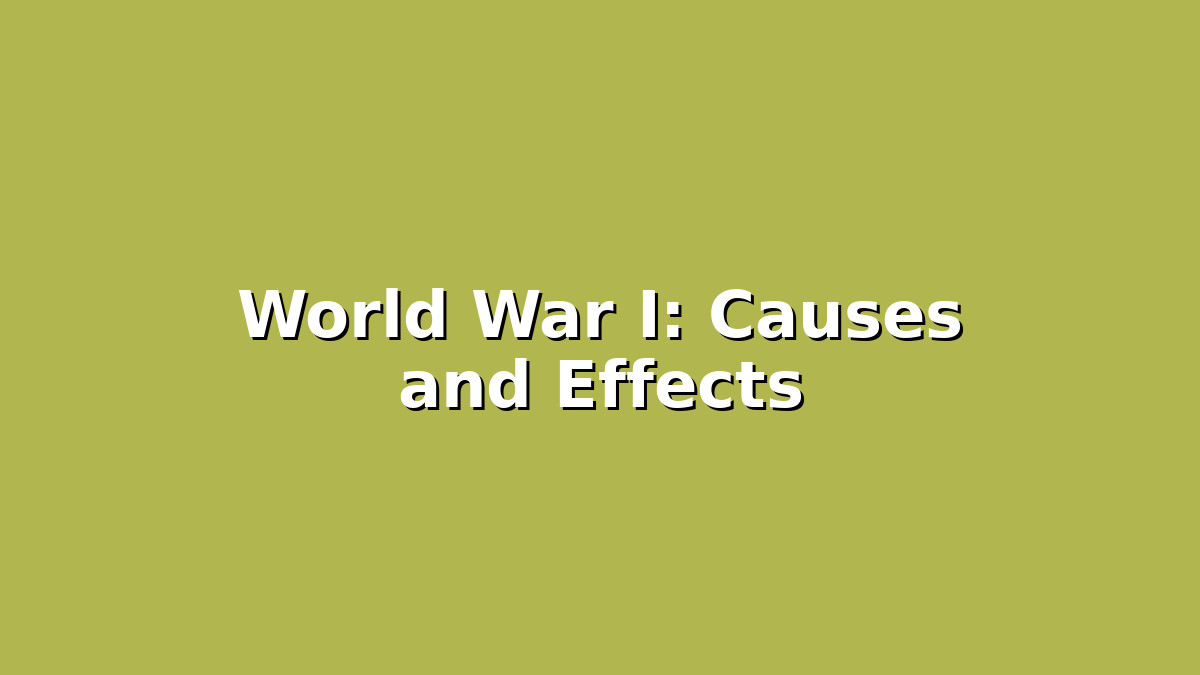World War I, also known as the Great War, remains one of the most significant events in modern history. For students preparing for exams, understanding the causes and effects of this monumental conflict is essential—not just for history tests but also for gaining insights into how global events shape the world. In this article, we’ll explore the main causes and far-reaching effects of World War I, along with practical study tips to help you absorb and remember the material effectively.
Introduction
World War I lasted from 1914 to 1918 and involved many of the world’s major powers divided into two opposing alliances: the Allies and the Central Powers. The war’s complexity can feel overwhelming, but breaking it down into clear causes and effects helps simplify the topic. By understanding why the war started and how it changed the world, students can build a strong foundation for essays, exams, and discussions.
Section 1: Causes of World War I—How to Tackle Complex Historical Causes in Your Studies
World War I did not start overnight; it was the result of numerous interconnected factors. Historians mainly point to four key causes:
1. Militarism: European nations engaged in an arms race, building powerful militaries and stockpiling weapons, which increased tensions and readiness for war.
2. Alliances: Two major alliance systems emerged—the Triple Entente (France, Russia, Britain) and the Triple Alliance (Germany, Austria-Hungary, Italy). These agreements meant a conflict involving one country could quickly involve others.
3. Imperialism: Competition for colonies and global influence created rivalries, especially between Britain, France, and Germany.
4. Nationalism: Strong national pride and ethnic tensions, particularly in the Balkans, increased hostility and desire for independence among various groups.
Study Tip: Create a cause-and-effect mind map. Start with World War I in the center and branch out into Militarism, Alliances, Imperialism, and Nationalism. Add details, dates, and examples around each branch. Visual aids like this help you see the connections clearly and make revision easier.
Another tip is to use mnemonic devices to remember the causes. For example, use the acronym MAIN (Militarism, Alliances, Imperialism, Nationalism) to recall the major causes quickly.
Section 2: The Spark That Ignited the War and How to Remember Key Events
Though the underlying causes built tension for years, the immediate trigger was the assassination of Archduke Franz Ferdinand of Austria-Hungary on June 28, 1914, by a Serbian nationalist. This event set off a chain reaction:
– Austria-Hungary’s ultimatum to Serbia
– Serbia’s rejection of some demands
– Austria-Hungary declaring war on Serbia
– Russia mobilizing to protect Serbia
– Germany declaring war on Russia and France
– Britain entering the war due to Germany’s invasion of Belgium
This rapid escalation led to a full-scale war engulfing much of Europe.
Study Tip: When learning complex timelines, try to link events to a story or narrative. Imagine the assassination as the “spark” in a powder keg. Visualizing the sequence like a story helps you remember the order and significance of events rather than memorizing disconnected facts.
Additionally, practice writing brief summaries of the timeline in your own words. This helps reinforce understanding and makes it easier to recall during exams.
Section 3: Effects of World War I and How to Prepare for Essay Questions
The effects of World War I were profound and long-lasting, shaping the 20th century in many ways:
– Political Changes: The collapse of empires such as Austro-Hungarian, Ottoman, Russian, and German Empires led to new countries in Europe and the Middle East.
– Treaty of Versailles: In 1919, the treaty officially ended the war but imposed heavy reparations and territorial losses on Germany, sowing seeds for World War II.
– Social Impact: The war caused millions of deaths and injuries, disrupting families and societies. It also changed social roles, including increased participation of women in the workforce.
– Economic Consequences: Many countries faced debt and economic hardship, leading to global instability and the Great Depression.
– Technological and Military Innovations: The war accelerated advancements in tanks, airplanes, chemical weapons, and trench warfare.
Study Tip: When tackling essay questions about World War I’s effects, organize your answers into clear categories, such as political, social, economic, and technological impacts. Use bullet points or headings in your planning to ensure your essay is structured and covers multiple perspectives.
Make sure to include specific examples, like the Treaty of Versailles or the rise of new nations, to demonstrate deeper understanding. Also, practice linking causes to effects, such as how the harsh terms of the treaty contributed to future conflicts.
Conclusion
Understanding World War I’s causes and effects is crucial for students preparing for exams because it provides insight into the complex web of historical events and their consequences. By breaking down the material into manageable parts, using study tools like mind maps and storytelling, and practicing essay organization, you can approach this topic with confidence.
Remember, history is not just about memorizing dates and facts—it’s about understanding how and why events connect and influence the world. Keep a positive mindset, practice regularly, and soon you’ll master the study of World War I and excel in your exams.
Good luck!

Responses